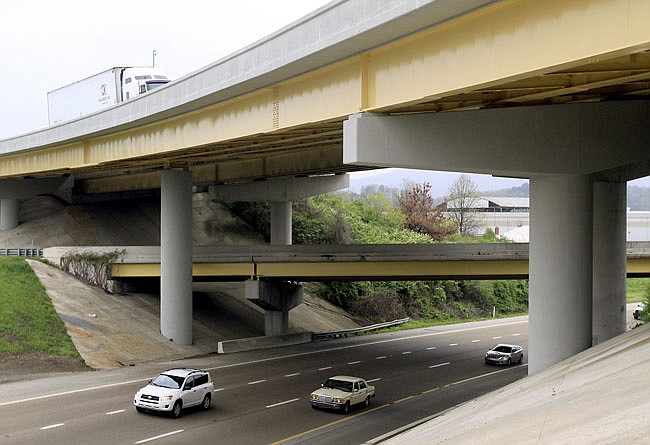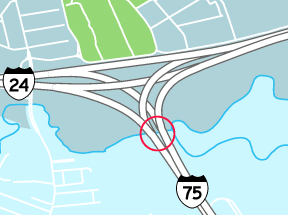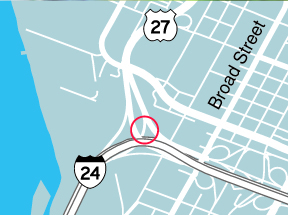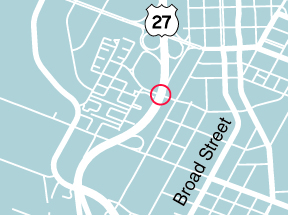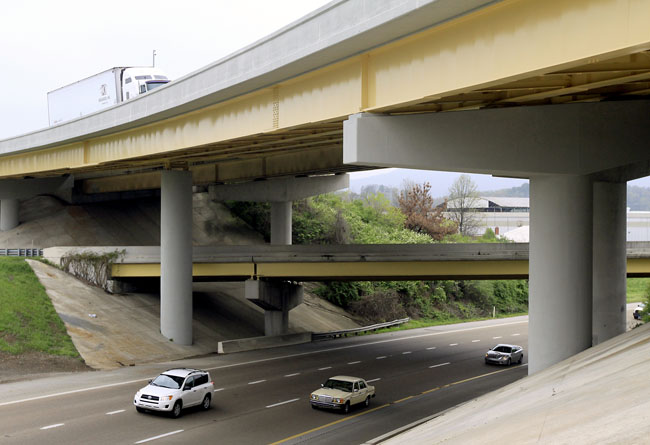 Motorists drive over the eastbound interchange of I-24 and U.S. 27, center bridge, late Tuesday morning. The eastbound bridge is labeled by the Transportation for America coalition as No. 3 on a list of Tennessee's 10 most structurally deficient bridges with the highest traffic volumes.
Staff Photo by Dan Henry/Chattanooga Times Free Press
Motorists drive over the eastbound interchange of I-24 and U.S. 27, center bridge, late Tuesday morning. The eastbound bridge is labeled by the Transportation for America coalition as No. 3 on a list of Tennessee's 10 most structurally deficient bridges with the highest traffic volumes.
Staff Photo by Dan Henry/Chattanooga Times Free PressFour of the 10 most structurally deficient bridges with highest traffic volumes in Tennessee are in Chattanooga and Hamilton County, according to an analysis of the National Bridge Inventory.
With crumbling edges and gaping pavement cracks, the spans are examples of the one in 16 state bridges that are in such disrepair an immediate fix would require $172 from every driver in Tennessee, states "The Fix We're in For," a report by Transportation for America.
Despite the fact that the report gives Tennessee high marks generally for its bridges, Hamilton County has the lion's share of the state's worst high-traffic spans. They are:
* No. 1 - The Interstate 75 bridge over Big Spring Creek, 1.9 miles north of Ringgold Road.
About 121,400 vehicles cross the bridge daily, according to the report.
* No. 3 - The Interstate 24 bridge in the eastbound lane near the intersection of I-24 and U.S. 27.
About 112,170 vehicles cross there daily.
* No. 6 and No. 7 - U.S. 27 northbound and southbound, over West 12th Street.
About 78,650 vehicles travel over both of these bridges daily.
"No one likes to land on the list of deficient bridges, but I do know the state is keeping up with inspections. I have no qualms about driving over those bridges," said Chattanooga Mayor Ron Littlefield.
Making improvements
The Tennessee Department of Transportation, which maintains all interstate and state bridges, has worked on all four bridges in the past year, according to TDOT spokeswoman Jennifer Flynn.
But the report reflects surveys made earlier for the 2010 National Bridge Inventory. Those survey ratings do not reflect the improvements, and the bridges no longer would be rated structurally deficient, she said.
"All four bridges are basically sound and are structurally fine for traffic, but they were downgraded due to their decks having cracks and spalled [crumbling] concrete," Flynn said.
In one case, Hamilton County I-24 eastbound over the U.S. 27 eastbound ramp to U.S. 27 North has had the entire bridge deck replaced, she said.
Additionally, the I-75 bridge over Big Spring Creek had deck repair performed last year, and the U.S. 27 northbound and southbound bridges had the decks repaired and an asphalt overlay placed on them in late 2009, she said.
That work upgraded the four bridges' ratings from "structurally deficient" to "fair," but the work wasn't done in time for the April 1 data submittal deadline for the 2010 National Bridges Inventory.
By law, state highway departments must inspect the state and interstate bridges measuring 20 feet or longer every two years and submit the findings to the Federal Highway Administration, which compiles the bridge inventory.
In Tennessee, that means inspecting about 10,000 bridges each year, and the results help state officials prioritize repairs.
In 2005 and 2006, Hamilton County's worst bridge, the Market Street Bridge, was closed for a complete rebuild. The $13 million effort not only made the bridge safe, it also restored the 1917 look of the largest bascule truss drawbridge east of the Mississippi River.
Looking ahead, TDOT's Steve Hutchings, assistant bridge engineer for this region, expects still more bridge improvements.
Hutchings said the bridges from the Tennessee River to the I-24/U.S. 27 split will be updated or widened when the work gets under way to widen U.S. 27, which was once called Interstate 124.
"I believe this project is supposed to begin in November," he said.
The national view
Despite billions of dollars in annual federal, state and local funds directed toward maintaining bridges, more than 11 percent of the nation's spans - 69,223 - are classified as "structurally deficient," according to the Federal Highway Administration.
The average age of an American bridge is 42 years, and many bridges exceed their expected life span of 50 years, the Transportation for America report states.
But Tennessee, which ranks fifth best in the country, has one of the nation's most impressive state records for bridge conditions, according to the report.
"In Tennessee, the Department of Transportation has adopted a policy to 'fix it first,' prioritizing repair and maintenance before costly reconstruction or rehabilitation is needed," the report states.
The state has 19,869 bridges, and 1,225 of them are rated as structurally deficient, according to Transportation for America, a coalition of housing, environmental, equity, public health, urban planning, transportation and other organizations.
Littlefield, who said Chattanooga is a member of that coalition, said he was delayed on a drive recently along Missionary Ridge as a state crew inspected a bridge there. He cited the event and the state's record on the Transportation for America report as more reasons he has confidence in local bridges.
"I'm not fearful for the conditions because I know that these [deficient] rankings have more to do with age and capacity rather than the threat of failure," he said.
"Plus we have a community with a very varied terrain and, because of that, we have more bridges than many communities," Littlefield said.
